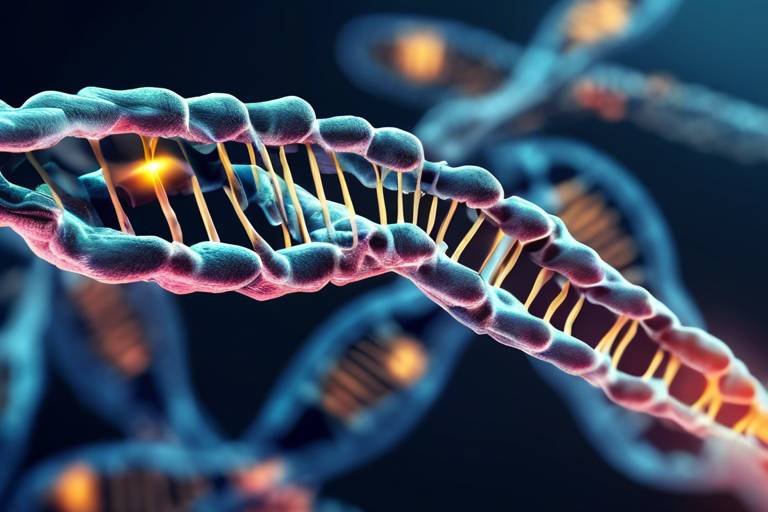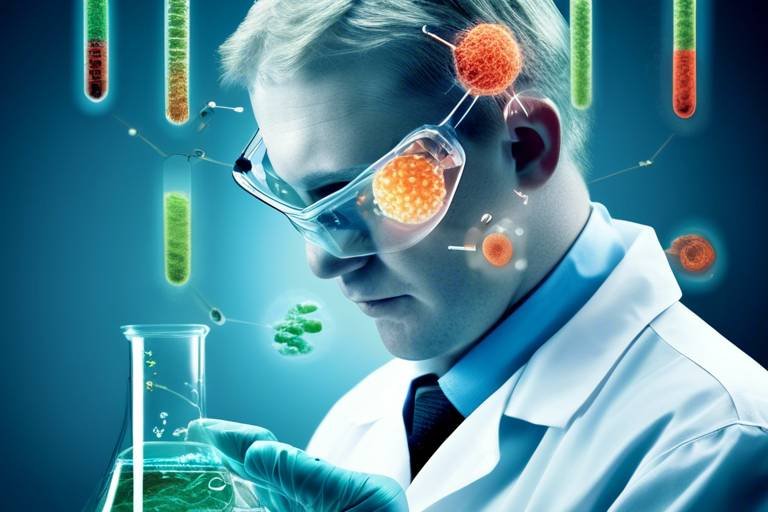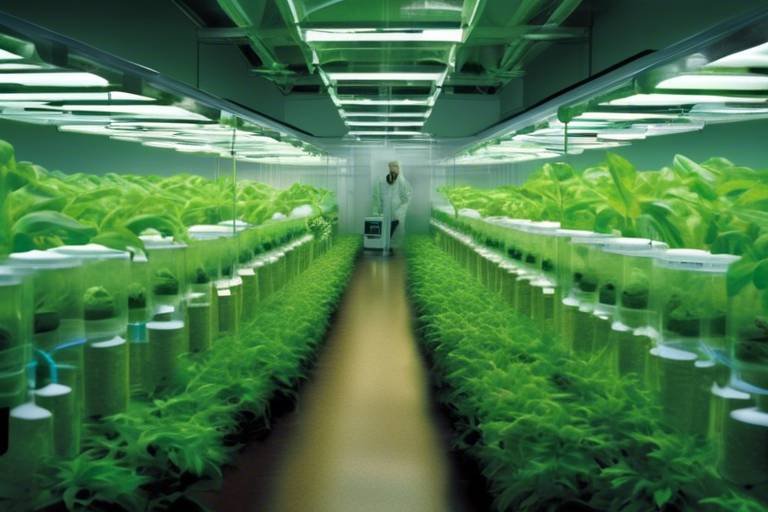The Future of Genetics - CRISPR and Gene Editing Technologies
Welcome to the exciting world of genetics, where the boundaries of science are being pushed further than ever before! At the forefront of this revolution is CRISPR technology, a groundbreaking tool that has transformed the landscape of gene editing. Imagine having the ability to edit the very blueprint of life, making precise changes to DNA as easily as correcting a typo in a document. This isn't science fiction; it's happening right now! In this article, we will explore the transformative potential of CRISPR and gene editing technologies, their applications, ethical considerations, and future directions in the field of genetics.
CRISPR, which stands for Clustered Regularly Interspaced Short Palindromic Repeats, is a natural defense mechanism found in bacteria. It allows these microorganisms to fend off viral attacks by cutting the DNA of invading viruses. Scientists harnessed this unique ability to create a powerful tool for gene editing. The process is akin to using a pair of molecular scissors, enabling researchers to snip out unwanted genes or insert new ones with remarkable precision. The significance of CRISPR in modern genetics cannot be overstated; it has opened up new avenues for research and therapy that were previously unimaginable.
The potential applications of gene editing in medicine are vast and varied. From treating genetic disorders to advancing personalized medicine, CRISPR is paving the way for innovative therapies that could change lives. One of the most exciting prospects is the ability to correct genetic mutations that cause hereditary diseases. Imagine a world where conditions like cystic fibrosis or sickle cell anemia could be treated at their source, providing patients with a chance at a healthier life. Researchers are currently exploring numerous avenues, and the results are promising.
CRISPR offers hope for treating hereditary diseases by correcting genetic mutations. For instance, in clinical trials, scientists have successfully used CRISPR to target and edit genes responsible for conditions like muscular dystrophy and beta-thalassemia. These breakthroughs not only demonstrate the technology's potential but also ignite hope for millions suffering from genetic disorders. However, while the results are encouraging, the journey from the lab to the clinic is filled with challenges that must be addressed.
Highlighting successful case studies provides insight into CRISPR's effectiveness in treating genetic disorders. For example, in one landmark trial, researchers treated a patient with sickle cell disease by editing their hematopoietic stem cells. The outcome was remarkable, with the patient showing significant improvement and a reduction in disease symptoms. Such success stories showcase the real-world applications of CRISPR and inspire further research into its therapeutic potential.
Despite its promise, challenges remain in the clinical use of CRISPR. One of the significant hurdles is ensuring accurate delivery of the CRISPR components to the target cells. Current methods, such as viral vectors, come with their own risks and limitations. Additionally, off-target effects, where unintended parts of the genome are edited, pose a significant concern. Researchers are actively working to refine these techniques, ensuring that CRISPR is not only effective but also safe for patients.
CRISPR is not limited to medicine; it also holds great promise in agriculture. The ability to edit the genes of crops can lead to improved resilience against pests, diseases, and environmental stresses. Imagine crops that can withstand drought or have enhanced nutritional content. This technology could significantly contribute to food security, especially in regions facing climate change challenges. By harnessing CRISPR, we can create a more sustainable agricultural future.
With great power comes great responsibility, and the power of gene editing raises significant ethical questions. The implications of manipulating the genetic makeup of organisms, including humans, are profound and complex. As we venture further into this uncharted territory, it is crucial to consider the moral implications and societal concerns surrounding CRISPR technology.
The possibility of creating designer babies through gene editing ignites heated debates about ethics and societal impact. Some argue that it could lead to a new era of personalized medicine, while others fear it might create societal divides based on genetic enhancements. This contentious issue raises questions about the limits of human intervention in natural processes. Are we playing God, or are we simply using science to improve lives? The answers are not straightforward, and differing viewpoints abound.
As gene editing technologies evolve, so must the regulatory frameworks governing their use. Current regulations vary widely across countries, and there is a pressing need for cohesive policies that ensure ethical practices in gene editing. Striking a balance between innovation and safety is essential, and ongoing discussions in the scientific community and among policymakers will shape the future of CRISPR technology.
- What is CRISPR? CRISPR is a gene-editing technology that allows for precise modifications to DNA.
- How does CRISPR work? CRISPR uses a guide RNA to locate specific DNA sequences and a Cas9 enzyme to cut the DNA at those locations.
- What are the potential applications of CRISPR? CRISPR has applications in medicine, agriculture, and even environmental management.
- Are there ethical concerns with CRISPR? Yes, ethical concerns include the possibility of designer babies and the implications of altering human genetics.
- What challenges does CRISPR face? Challenges include delivery mechanisms, off-target effects, and regulatory hurdles.

Understanding CRISPR Technology
CRISPR technology has truly revolutionized the field of genetics, offering a precise and efficient way to modify DNA. But what exactly is CRISPR? The term stands for "Clustered Regularly Interspaced Short Palindromic Repeats," and it was discovered in the immune systems of bacteria. These tiny organisms use CRISPR as a defense mechanism against viruses, capturing snippets of viral DNA and using them to recognize and eliminate future threats. This natural process inspired scientists to harness its power for gene editing, leading to groundbreaking advancements in the field.
The mechanism behind CRISPR is fascinating and can be broken down into a few key components: Cas9 (the molecular scissors), guide RNA (the GPS), and the target DNA. The guide RNA is designed to match a specific sequence in the DNA that researchers want to edit. Once the guide RNA binds to the target DNA, the Cas9 enzyme swoops in and makes a cut, allowing for the insertion or deletion of genetic material. This precision is akin to using a word processor to edit a document—just select the text you want to change and make your adjustments!
What makes CRISPR particularly significant is its versatility and accessibility. Unlike previous gene-editing technologies, which were often cumbersome and less precise, CRISPR allows scientists to make targeted changes quickly and efficiently. This democratization of gene editing has opened up a world of possibilities, not just in research labs but also in real-world applications. From agriculture to medicine, the implications are vast and exciting.
To appreciate the impact of CRISPR, let’s look at some of its potential applications:
- Gene Therapy: Correcting genetic disorders by repairing faulty genes.
- Crop Improvement: Enhancing traits in plants, such as drought resistance or nutritional value.
- Biotechnology: Developing new biofuels and other sustainable resources.
In summary, CRISPR technology is a game-changer in genetics, providing a powerful tool for researchers to explore and manipulate the very building blocks of life. Its discovery has not only transformed our understanding of genetic material but has also paved the way for innovations that could redefine healthcare, agriculture, and beyond. As we delve deeper into its applications, it’s essential to consider the ethical implications and responsibilities that come with such power.

Applications in Medicine
The realm of medicine is undergoing a remarkable transformation, thanks to the advent of gene editing technologies like CRISPR. This innovative approach is not just a scientific breakthrough; it is a beacon of hope for millions grappling with genetic disorders. Imagine a world where diseases caused by faulty genes can be corrected at their source. This is not science fiction; this is the reality that CRISPR is paving the way for. With its ability to make precise modifications to DNA, CRISPR holds the potential to revolutionize not just treatment options, but the entire landscape of healthcare.
One of the most promising applications of CRISPR in medicine lies in the treatment of genetic disorders. Conditions such as sickle cell anemia, cystic fibrosis, and muscular dystrophy are just a few examples of diseases that could potentially be treated by correcting the underlying genetic mutations. Researchers are exploring various avenues, including gene therapy, where faulty genes can be repaired or replaced, providing a long-term solution rather than temporary relief. The excitement around these advancements is palpable, as clinical trials are already underway, showcasing CRISPR's potential in real-world applications.
CRISPR technology has emerged as a powerful tool in the fight against hereditary diseases. By directly targeting and correcting genetic mutations, scientists are opening doors that were previously thought to be locked forever. For instance, in recent clinical trials, researchers have successfully utilized CRISPR to treat patients with sickle cell disease, a condition that has plagued individuals for generations. The process involves editing the patient's own cells to produce healthy red blood cells, effectively alleviating the symptoms of the disease. This case exemplifies how CRISPR is not just a theoretical concept; it is actively changing lives.
Several case studies have emerged that highlight the effectiveness of CRISPR in treating genetic disorders. For example, a landmark trial conducted in 2020 involved a patient with beta-thalassemia, a blood disorder caused by mutations in the hemoglobin gene. After undergoing CRISPR treatment, the patient was able to produce normal hemoglobin levels, significantly improving their quality of life. Such success stories are not isolated; they represent a growing body of evidence supporting CRISPR's role in therapeutic applications. The table below summarizes some notable clinical trials involving CRISPR:
| Condition | CRISPR Application | Outcome |
|---|---|---|
| Sickle Cell Disease | Editing of HBB gene | Improved hemoglobin levels |
| Beta-Thalassemia | Correction of mutations | Normal hemoglobin production |
| Muscular Dystrophy | Gene repair techniques | Increased muscle function |
Despite the exhilarating potential of CRISPR, the journey toward widespread clinical application is not without its hurdles. One of the primary challenges is the delivery mechanism of CRISPR components into the target cells. Scientists are continuously working on developing efficient delivery systems that ensure CRISPR reaches the right cells without causing unintended effects. Another significant concern is the possibility of off-target effects, where CRISPR inadvertently edits unintended parts of the genome. Addressing these challenges is crucial for the successful integration of CRISPR into mainstream medicine.
In summary, the applications of CRISPR in medicine are vast and varied, offering a glimpse into a future where genetic disorders can be effectively treated. As research progresses, the hope is that these technologies will not only enhance patient outcomes but also lead to a paradigm shift in how we approach healthcare.
- What is CRISPR technology? - CRISPR is a gene-editing technology that allows scientists to modify DNA with high precision.
- How does CRISPR work? - CRISPR uses a guide RNA to locate specific DNA sequences, enabling the editing of genes by cutting and replacing them.
- What diseases can CRISPR potentially treat? - CRISPR has the potential to treat a wide range of genetic disorders, including sickle cell disease, cystic fibrosis, and muscular dystrophy.
- Are there ethical concerns associated with CRISPR? - Yes, there are significant ethical considerations, particularly regarding the potential for creating "designer babies" and the long-term effects of gene editing.

Genetic Disorders Treatment
One of the most exciting prospects of CRISPR technology is its potential to revolutionize the treatment of genetic disorders. Imagine a world where inherited diseases, once deemed incurable, can be corrected at their source. This is not just a dream; it’s becoming a reality. CRISPR allows scientists to precisely edit genes, which means that they can potentially fix mutations that cause conditions such as cystic fibrosis, sickle cell anemia, and muscular dystrophy. By targeting the specific genes responsible for these disorders, researchers are paving the way for therapies that could change lives.
For instance, in recent clinical trials, CRISPR has been used to treat patients with sickle cell disease. This condition, characterized by abnormally shaped red blood cells, can lead to severe pain and complications. By editing the patient's own stem cells to produce healthy red blood cells, researchers have seen promising results. Patients treated with CRISPR have reported significant improvements in their symptoms, highlighting the transformative potential of this technology.
Moreover, the approach is not limited to blood disorders. Researchers are exploring the use of CRISPR in various genetic conditions. Some notable examples include:
- Cystic Fibrosis: By correcting the CFTR gene mutation, scientists hope to restore normal function to the lungs and digestive system.
- Muscular Dystrophy: CRISPR is being studied as a method to repair the dystrophin gene, potentially halting the progression of this debilitating disease.
- Beta-Thalassemia: This blood disorder can be treated by editing the HBB gene to produce normal hemoglobin.
However, while the potential is enormous, it is essential to approach these advancements with caution. The journey from laboratory to clinic is fraught with challenges. One significant hurdle is ensuring that the CRISPR edits are made accurately and do not affect unintended parts of the genome, which can lead to off-target effects. These unintended edits could potentially introduce new health issues, which is why ongoing research is critical.
Additionally, the logistics of delivering CRISPR components into the patient's cells pose another challenge. Current delivery methods, such as viral vectors, have limitations and can trigger immune responses. Researchers are actively exploring alternative delivery systems, including nanoparticles and liposomes, to enhance the precision and safety of gene editing.
In conclusion, the treatment of genetic disorders using CRISPR technology is a groundbreaking advancement that offers hope to millions. While there are challenges to overcome, the progress made in clinical trials is a testament to the potential of gene editing. As research continues, we may soon witness a future where genetic disorders are not just managed but effectively cured.
1. What is CRISPR?
CRISPR is a revolutionary gene-editing technology that allows scientists to make precise changes to the DNA of living organisms.
2. How does CRISPR work?
CRISPR uses a guide RNA to locate specific DNA sequences and a protein called Cas9 to cut the DNA, allowing for the addition or removal of genetic material.
3. What genetic disorders can CRISPR potentially treat?
CRISPR has shown promise in treating various genetic disorders, including cystic fibrosis, sickle cell anemia, and muscular dystrophy.
4. Are there risks associated with CRISPR?
Yes, potential risks include off-target effects, where unintended parts of the genome are altered, and challenges in effectively delivering CRISPR components into cells.
5. Is CRISPR technology available for clinical use?
While CRISPR is still largely in the research phase, some clinical trials are underway, and there is hope for broader applications in the near future.

Case Studies in Clinical Trials
The implementation of CRISPR technology in clinical trials has opened a new chapter in the treatment of genetic disorders, showcasing its potential to revolutionize medicine. One of the most notable case studies involves a patient with sickle cell disease, a hereditary blood disorder caused by a mutation in the hemoglobin gene. Using CRISPR, researchers were able to edit the patient's cells to correct this mutation. The results were nothing short of miraculous—after undergoing treatment, the patient experienced a significant reduction in symptoms and a marked improvement in quality of life. This case highlights not only the effectiveness of CRISPR but also the hope it brings to countless individuals suffering from genetic disorders.
Another compelling case study revolves around the treatment of Leber congenital amaurosis, a rare genetic eye disorder that can lead to blindness. In a groundbreaking trial, scientists used CRISPR to target the specific gene responsible for this condition. By delivering the CRISPR components directly into the patient's eye, they were able to restore some level of vision. This case illustrates how CRISPR can be tailored for localized treatment, providing a glimpse into the future of personalized medicine.
However, it's essential to recognize that while these success stories are promising, they are just the tip of the iceberg. The clinical trials involving CRISPR are still in their infancy, and researchers are continuously working to refine techniques and ensure safety. For instance, a recent study focused on using CRISPR to treat beta-thalassemia, another blood disorder. The trial aimed to demonstrate not only the effectiveness of the gene editing but also to address potential off-target effects—unintended modifications to other genes that could lead to complications. The researchers reported encouraging results, but they emphasized the need for ongoing monitoring and long-term studies to fully understand the implications of such treatments.
To better illustrate the impact of these trials, the following table summarizes key case studies of CRISPR in clinical applications:
| Condition | CRISPR Application | Outcome |
|---|---|---|
| Sickle Cell Disease | Gene editing to correct hemoglobin mutation | Significant symptom reduction and improved quality of life |
| Leber Congenital Amaurosis | Targeting genes responsible for vision loss | Restoration of some vision |
| Beta-Thalassemia | Editing genes related to hemoglobin production | Encouraging results with a focus on monitoring |
These case studies not only demonstrate the potential of CRISPR technology but also highlight the ongoing challenges researchers face in ensuring safety and efficacy. As we move forward, the lessons learned from these trials will shape the future of gene editing and its applications in medicine.
- What is CRISPR technology? CRISPR is a revolutionary gene editing tool that allows scientists to make precise changes to DNA, potentially correcting genetic disorders.
- How does CRISPR work? CRISPR uses a guide RNA to identify specific DNA sequences and an enzyme (usually Cas9) to cut the DNA, allowing for modifications.
- What are the ethical concerns surrounding CRISPR? Ethical concerns include the potential for "designer babies," unintended consequences of gene editing, and the need for regulations to govern its use.
- Are there risks associated with CRISPR treatments? Yes, potential risks include off-target effects, where unintended parts of the genome are altered, and long-term effects that are still being studied.

Challenges in Implementation
While the potential of CRISPR technology is nothing short of revolutionary, implementing it in clinical settings is fraught with challenges. One of the most significant hurdles is the issue of delivery mechanisms. Imagine trying to send a letter to a friend but only being able to deliver it to the wrong address. In the context of gene editing, ensuring that CRISPR components reach the correct cells in the body is crucial. Various delivery methods, such as viral vectors, nanoparticles, and liposomes, are being explored, but each comes with its own set of limitations and risks.
Another major concern is the possibility of off-target effects. This is akin to a skilled archer missing the bullseye and hitting an unintended target instead. In gene editing, off-target effects occur when CRISPR inadvertently alters genes other than the intended ones, potentially leading to unforeseen consequences. Researchers are actively working on improving the specificity of CRISPR systems, but this remains a significant challenge that could impact the safety and efficacy of treatments.
Moreover, the regulatory landscape surrounding gene editing is still evolving. As scientists push the boundaries of what is possible with CRISPR, regulatory bodies must keep pace to ensure safe and ethical use. The lack of clear guidelines can create uncertainty for researchers and healthcare providers alike. This uncertainty can slow down the progress of clinical trials and the eventual rollout of therapies that could benefit patients.
In addition to these technical challenges, there are also ethical considerations that must be addressed. For instance, the potential for gene editing to be used in ways that could exacerbate social inequalities raises important questions. How do we ensure that these groundbreaking technologies are accessible to all, rather than just a privileged few? This ethical dimension adds another layer of complexity to the implementation of CRISPR in medicine and agriculture.
Finally, public perception plays a crucial role in the acceptance of CRISPR technologies. Misunderstandings and fears surrounding gene editing can lead to public resistance, which in turn can influence regulatory decisions and funding for research. Engaging with the public, providing clear information, and addressing concerns will be essential for the successful integration of CRISPR into everyday applications.
In summary, while CRISPR technology offers incredible potential, its implementation faces a multitude of challenges. From technical issues like delivery and off-target effects to ethical dilemmas and public perception, overcoming these obstacles will require collaboration among scientists, ethicists, regulators, and the community at large.
- What is CRISPR technology? CRISPR is a revolutionary gene-editing tool that allows scientists to modify DNA with high precision.
- What are the main applications of CRISPR? CRISPR has applications in medicine, agriculture, and biotechnology, including the treatment of genetic disorders and improving crop resilience.
- What are the ethical concerns surrounding CRISPR? Ethical concerns include the potential for designer babies, equity in access to technology, and the long-term effects of gene editing.
- How does CRISPR affect existing regulations? The rapid advancement of CRISPR technology necessitates the development of new regulatory frameworks to ensure safe and ethical use.
- What challenges does CRISPR face in clinical settings? Challenges include delivery mechanisms, off-target effects, and navigating the regulatory landscape.

Advancements in Agriculture
When we think about the future of food production, the word innovation often comes to mind. One of the most groundbreaking advancements in this arena is the use of CRISPR technology in agriculture. Imagine being able to edit the DNA of crops with the precision of a word processor—this is what CRISPR allows us to do. By making specific changes to the genetic code of plants, we can create crops that are not only more resilient but also more nutritious. This technology is akin to giving crops a superpower, enabling them to withstand harsh conditions such as drought, pests, and diseases.
For instance, researchers have successfully developed rice varieties that can thrive in saline soils, which is a game-changer for regions affected by rising sea levels. This is crucial because it could potentially increase food security in areas where traditional crops would fail. Moreover, CRISPR can enhance the nutritional profiles of crops, making them richer in vitamins and minerals. Picture a tomato that has higher levels of antioxidants—this is not science fiction; it's becoming a reality.
But how does this all work? CRISPR acts like a pair of molecular scissors, allowing scientists to cut DNA at specific locations. Once the DNA is cut, the cell's natural repair mechanisms kick in, and during this repair process, scientists can introduce changes that lead to desirable traits. This method is not only efficient but also significantly faster than traditional breeding methods, which can take years or even decades. The table below summarizes some of the key advancements in agricultural CRISPR applications:
| Crop Type | Trait Enhanced | Impact |
|---|---|---|
| Rice | Salt tolerance | Increased yield in saline soils |
| Wheat | Disease resistance | Reduced crop loss and increased food security |
| Tomato | Enhanced nutritional value | Improved health benefits for consumers |
| Maize | Insect resistance | Lower pesticide use, environmental benefits |
However, the journey of CRISPR in agriculture is not without its challenges. The technology is still relatively new, and there are concerns about unintended consequences in the ecosystem. For example, will these genetically edited crops affect local biodiversity? Will they crossbreed with wild relatives? These questions are crucial as we move forward with CRISPR technology in farming. It's essential to strike a balance between innovation and environmental stewardship.
In summary, CRISPR technology represents a revolution in agriculture, offering solutions to some of the most pressing challenges in food production today. As we harness the power of gene editing, we must remain vigilant about the ethical implications and ensure that these advancements benefit all of humanity, not just a select few. The future of agriculture is bright, and with CRISPR, we are on the brink of a new era in food security and sustainability.
- What is CRISPR technology? CRISPR is a gene-editing technology that allows scientists to modify DNA with high precision.
- How does CRISPR benefit agriculture? It can create crops that are more resilient to environmental stresses, pests, and diseases, while also enhancing nutritional value.
- Are there any risks associated with CRISPR in agriculture? Yes, potential risks include unintended effects on the ecosystem and biodiversity, which require careful monitoring and regulation.
- Is CRISPR technology safe for human consumption? Current research suggests that CRISPR-edited crops are safe, but ongoing studies and regulatory reviews are essential.

Ethical Considerations
The advent of CRISPR and gene editing technologies has opened up a Pandora's box of ethical dilemmas. These powerful tools allow scientists to make precise alterations to the DNA of living organisms, raising questions about the ramifications of such capabilities. Are we, as a society, prepared to wield this power responsibly? The implications of gene editing extend far beyond the laboratory, impacting everything from healthcare to agriculture and even our very understanding of what it means to be human.
One of the most contentious issues surrounding CRISPR technology is the potential for creating designer babies. Imagine a world where parents can select traits for their children, such as intelligence, physical appearance, or even predisposition to certain diseases. While this may sound like something out of a science fiction novel, the reality is that the technology is rapidly advancing. This possibility ignites fierce debates among ethicists, scientists, and the public. On one hand, proponents argue that gene editing could eliminate hereditary diseases and improve quality of life. On the other hand, critics warn of the societal implications, including inequality and the commodification of human life.
Moreover, the ethical landscape is further complicated by the concept of access and equity. As gene editing becomes more accessible, who gets to benefit from these advancements? Will only the wealthy have the means to enhance their offspring, leading to a new form of social stratification? This concern is particularly relevant in light of historical inequities in healthcare access. It raises the question: should gene editing be available to everyone, or should it be regulated to prevent misuse? These discussions are critical as we navigate the future of genetics.
Another important aspect to consider is the regulatory frameworks that govern gene editing technologies. As the field evolves, so too must the laws and guidelines that ensure ethical practices. Currently, regulations vary widely across countries, leading to a patchwork of standards that can confuse both researchers and the public. There’s an urgent need for comprehensive policies that address not only the scientific aspects of gene editing but also the ethical implications. This includes establishing clear guidelines for clinical trials and ensuring informed consent from participants.
Finally, the potential for unintended consequences cannot be overlooked. While CRISPR technology is heralded for its precision, the risk of off-target effects—where unintended parts of the genome are altered—poses ethical concerns. The long-term effects of such changes are still largely unknown. This uncertainty raises the question of whether we should proceed with caution or embrace the potential benefits of gene editing. Balancing innovation with ethical responsibility is essential for the future of genetics.
- What is CRISPR technology? - CRISPR is a revolutionary gene-editing tool that allows scientists to modify DNA with high precision.
- What are the ethical concerns surrounding gene editing? - Ethical concerns include the creation of designer babies, access and equity issues, regulatory frameworks, and the potential for unintended consequences.
- How does gene editing impact healthcare? - Gene editing holds the potential to treat genetic disorders, personalize medicine, and improve overall health outcomes.
- What regulations exist for gene editing? - Regulations vary by country, and there is a growing need for comprehensive policies to ensure ethical practices in gene editing.

Designer Babies Debate
The concept of designer babies—children genetically engineered to possess specific traits—has sparked a whirlwind of debate among scientists, ethicists, and the general public. Imagine a world where parents can choose their child's eye color, intelligence, or even athletic prowess. Sounds like science fiction, right? Yet, with the advent of CRISPR and gene editing technologies, this reality is inching closer. But with great power comes great responsibility, and the ethical implications of such capabilities are profound.
On one hand, proponents argue that gene editing could eliminate hereditary diseases, enhancing the quality of life for future generations. They envision a future where conditions like cystic fibrosis or sickle cell anemia could be eradicated before a child is even born. This perspective is compelling; after all, who wouldn't want to give their child the best possible start in life? However, critics raise alarming concerns about the potential for social inequality. If only the wealthy can afford genetic modifications, we could be heading towards a society divided not just by wealth, but by genetic advantages.
Moreover, the idea of playing God is a recurring theme in these discussions. Is it ethical to alter the very fabric of human life? Many argue that we should respect the natural course of evolution, while others believe that we have a moral obligation to use our technological advancements to alleviate suffering. This dichotomy raises questions about consent as well: Can we truly say that a child has consented to be genetically modified before they even exist?
To further complicate matters, the long-term effects of gene editing are still largely unknown. While CRISPR allows for precise alterations, the potential for unintended consequences—like off-target mutations—remains a significant concern. These unintended changes could lead to new health issues that may not manifest until years later, leaving us wondering if our attempts to improve humanity could instead introduce new problems.
As we navigate this complex landscape, it becomes crucial to establish a framework for discussions around gene editing. Open dialogues involving scientists, ethicists, policymakers, and the public are essential. Only through collaboration can we hope to address the myriad of concerns surrounding designer babies. This includes setting boundaries on what should and shouldn't be permissible when it comes to genetic modifications.
In conclusion, the debate on designer babies is not just about the technology itself, but about the kind of society we wish to create. Will we embrace our newfound capabilities responsibly, or will we risk creating a world where genetic privilege reigns? As we stand on the precipice of this new frontier, it's imperative that we approach the subject with caution, consideration, and a commitment to ethical practices.
- What are designer babies? Designer babies are children whose genetic characteristics have been artificially selected or altered through gene editing technologies like CRISPR.
- What are the ethical concerns surrounding designer babies? Ethical concerns include potential social inequality, the morality of altering human genetics, consent issues, and the unknown long-term effects of genetic modifications.
- Can gene editing eliminate hereditary diseases? Yes, gene editing has the potential to eliminate certain hereditary diseases by correcting genetic mutations before a child is born.
- What is the role of regulation in gene editing? Regulatory frameworks are essential to ensure that gene editing practices are ethical and safe, guiding the responsible use of technology in society.

designer babies
This article explores the transformative potential of CRISPR and gene editing technologies, their applications, ethical considerations, and future directions in the field of genetics.
CRISPR technology revolutionizes gene editing by allowing precise modifications to DNA. This section will delve into its discovery, mechanism, and significance in modern genetics.
Gene editing has vast potential in medicine, from treating genetic disorders to advancing personalized medicine. Here, we explore the most promising applications and ongoing research.
CRISPR offers hope for treating hereditary diseases by correcting genetic mutations. This subsection discusses specific cases where CRISPR has shown potential in clinical trials.
Highlighting successful case studies provides insight into CRISPR's effectiveness in treating genetic disorders, showcasing real-world applications and outcomes.
Despite its promise, challenges remain in the clinical use of CRISPR, including delivery mechanisms and off-target effects. This section addresses these hurdles.
CRISPR is not limited to medicine; it also holds great promise in agriculture. This subsection explores how gene editing can improve crop resilience and yield.
The power of gene editing raises significant ethical questions. This section discusses the moral implications and societal concerns surrounding CRISPR technology.
The notion of —children whose genetic traits are deliberately altered—sparks intense debates that challenge our understanding of ethics, morality, and the very fabric of society. Imagine a future where parents can choose their child's eye color, intelligence, or even athletic ability. Sounds appealing, right? But at what cost? The potential to design our offspring raises questions that linger in the air like smoke from a fire: Are we playing God? Will this lead to a society divided by genetic privilege? These questions are not just hypothetical; they reflect real concerns that scientists, ethicists, and society at large grapple with.
As we dive deeper into this topic, it’s essential to consider the implications of such capabilities. The idea of selecting traits can lead to a variety of ethical dilemmas, including:
- Socioeconomic Divide: Will only the wealthy have access to these technologies, creating a new class of genetically enhanced individuals?
- Unintended Consequences: What if the traits we select lead to unforeseen health issues or psychological impacts?
- Loss of Genetic Diversity: Could this push us towards a homogenized gene pool, making humanity more susceptible to diseases?
While the allure of creating the "perfect" child is captivating, the reality is far more complex. The ethical landscape is fraught with challenges, and the potential for misuse is significant. As we continue to explore the boundaries of CRISPR technology, it’s crucial to engage in open dialogues about the responsibilities that come with such power.
As gene editing technologies evolve, so must the regulatory frameworks governing their use. This section discusses current regulations and the need for future policies to ensure ethical practices.
1. What are designer babies?
Designer babies refer to children whose genetic characteristics have been artificially selected or altered through genetic engineering techniques, such as CRISPR.
2. Are designer babies safe?
The safety of designer babies is a significant concern, as gene editing can have unintended consequences and long-term effects that are not yet fully understood.
3. What ethical issues surround designer babies?
Ethical issues include the potential for socioeconomic divides, unintended health consequences, and the moral implications of altering human genetics.
4. Is gene editing currently legal?
The legality of gene editing varies by country, with some nations having strict regulations while others have more lenient policies regarding genetic modifications.

through gene editing ignites heated debates about ethics and societal impact. This subsection examines various viewpoints on this controversial topic.
The concept of creating designer babies through gene editing is a topic that stirs up intense emotions and heated debates. Imagine a world where parents can select specific traits for their children, from physical attributes to intelligence levels. Sounds like science fiction, right? Yet, with the advent of CRISPR technology, this possibility is inching closer to reality. But at what cost? This question lies at the heart of the ethical discussions surrounding gene editing.
On one side of the debate, proponents argue that gene editing could eliminate genetic disorders and enhance the overall quality of life. For instance, if a couple knows they carry a gene for a severe hereditary condition, they might feel justified in using CRISPR to ensure their child is free from that burden. The potential to eradicate diseases like cystic fibrosis or sickle cell anemia is undeniably appealing. However, this brings us to the other side of the argument, where critics warn that such practices could lead to a slippery slope of eugenics, where only certain traits are deemed desirable, marginalizing those who do not fit this mold.
Moreover, the societal implications of gene editing are profound. Consider the possibility of a genetic divide emerging between those who can afford gene editing and those who cannot. This could exacerbate existing inequalities and create a society where genetic enhancement becomes a privilege of the wealthy. The consequences of such a divide could be far-reaching, impacting everything from job opportunities to social status.
Furthermore, the question of consent arises. How can we ensure that the child, who has no say in the matter, agrees with the genetic modifications made by their parents? This leads us to ponder the moral responsibilities of parents and the potential psychological impacts on the child. Will they feel pressure to live up to the expectations set by their genetically tailored traits?
As we navigate these complex waters, it's clear that the debate on designer babies is not just about science; it’s a reflection of our values as a society. To better understand the various viewpoints, let’s break them down:
- Proponents of Gene Editing: They believe in the potential to eradicate genetic diseases and improve quality of life.
- Ethical Concerns: Critics warn of the dangers of eugenics and the creation of a genetic divide.
- Consent Issues: The ethical implications of making irreversible decisions for future generations are concerning.
- Societal Impact: The possibility of widening social inequalities is a significant concern.
In conclusion, the debate surrounding designer babies through gene editing is a complex interplay of science, ethics, and societal values. As we stand on the brink of a new era in genetics, it is vital to engage in open dialogues that consider all perspectives. The future of our species could very well depend on the choices we make today.

Regulatory Frameworks
The rapid evolution of gene editing technologies, particularly CRISPR, has outpaced the development of regulatory frameworks designed to govern their use. This discrepancy raises critical questions about how society can ensure that these powerful tools are used responsibly and ethically. As scientists continue to unlock the potential of gene editing, regulatory bodies around the world are grappling with how to create guidelines that protect public health while fostering innovation.
Currently, regulatory frameworks vary significantly from one country to another. For instance, in the United States, the Food and Drug Administration (FDA) oversees clinical applications of gene editing, while the U.S. Department of Agriculture (USDA) regulates genetically modified organisms (GMOs). In contrast, the European Union has a more stringent approach, requiring extensive risk assessments and labeling for genetically modified products. This inconsistency can create challenges for researchers and companies looking to navigate the global landscape of gene editing.
One of the fundamental issues in establishing effective regulatory frameworks is the need for clear definitions. What exactly constitutes a genetically modified organism? How do we categorize gene-edited crops versus traditional GMOs? These questions are pivotal in shaping policies that can adequately address public concerns while promoting scientific advancement. Moreover, as new technologies emerge, regulations must be adaptable to encompass a wide range of applications, from agricultural innovations to potential human therapies.
In addition to defining regulations, there is a pressing need for public engagement in the regulatory process. The general public often harbors misconceptions about gene editing, which can lead to fear and resistance against its applications. To build trust, regulatory bodies must prioritize transparency and education, ensuring that the public understands both the benefits and risks associated with these technologies. Engaging in open dialogues about ethical considerations and potential societal impacts can help demystify gene editing and foster a more informed public discourse.
Another crucial aspect of regulatory frameworks is the establishment of international cooperation. Since gene editing does not recognize borders, global collaboration is essential to create cohesive guidelines that can address potential risks and ethical dilemmas. Organizations like the World Health Organization (WHO) and the United Nations (UN) play vital roles in facilitating discussions among nations to harmonize regulations and share best practices. Such cooperation can help mitigate the risks of "regulatory arbitrage," where companies might relocate operations to countries with lax regulations.
As we look to the future, it is clear that the regulatory landscape for gene editing technologies must evolve alongside scientific advancements. This evolution will require a delicate balance between fostering innovation and ensuring safety. Policymakers must engage with scientists, ethicists, and the public to craft regulations that not only protect society but also encourage the responsible use of gene editing technologies. The road ahead is complex, but with thoughtful governance, we can harness the transformative potential of CRISPR and gene editing for the betterment of humanity.
- What are the main regulatory bodies overseeing gene editing? In the U.S., the FDA and USDA are the primary regulators, while the EU has its own stringent regulatory framework.
- Why is public engagement important in regulatory processes? Engaging the public helps to build trust and understanding, addressing misconceptions about gene editing technologies.
- How do international regulations impact gene editing? Global cooperation is essential to prevent regulatory arbitrage and ensure consistent safety standards across borders.
- What ethical concerns are associated with gene editing? Ethical concerns include the potential for designer babies, unintended consequences of gene modifications, and the need for equitable access to technologies.
Frequently Asked Questions
- What is CRISPR technology?
CRISPR technology is a groundbreaking tool for editing genes with remarkable precision. It allows scientists to modify DNA sequences, enabling them to alter genetic information in living organisms. This technology has opened up new avenues in genetics, from research to practical applications in medicine and agriculture.
- How does CRISPR work?
CRISPR works by utilizing a natural defense mechanism found in bacteria. It employs a guide RNA to locate specific DNA sequences, and then an enzyme called Cas9 cuts the DNA at the targeted site. This allows for the removal or addition of genetic material, making it a powerful tool for gene editing.
- What are the potential medical applications of CRISPR?
CRISPR holds immense potential in medicine, particularly in treating genetic disorders. It can be used to correct mutations that cause diseases, develop personalized medicine approaches, and even target cancer cells. Ongoing research is exploring its effectiveness in various clinical trials.
- Are there any risks associated with CRISPR?
Yes, while CRISPR is a powerful technology, it is not without risks. Potential issues include off-target effects, where unintended parts of the genome are altered, and challenges in delivering the CRISPR components into cells. These factors need to be carefully managed as research progresses.
- What ethical concerns are associated with gene editing?
The ethical implications of gene editing are significant. Concerns include the potential for creating 'designer babies', where genetic traits are selected based on preference, and the societal impact of such practices. Discussions around equitable access to these technologies and the long-term consequences are ongoing.
- How is CRISPR regulated?
Regulation of CRISPR technology varies by country and is still evolving. Current frameworks focus on safety and ethical considerations, but as the technology advances, new policies will be necessary to address emerging challenges and ensure responsible use.
- Can CRISPR be used in agriculture?
Absolutely! CRISPR is making waves in agriculture by enhancing crop resilience and yield. It can help create plants that are resistant to diseases, pests, and environmental stresses, ultimately leading to more sustainable farming practices.
- What are some successful case studies involving CRISPR?
Several case studies highlight CRISPR's effectiveness, including trials aimed at treating genetic disorders like sickle cell disease and beta-thalassemia. These cases demonstrate real-world applications and the potential for positive outcomes in patients.



















